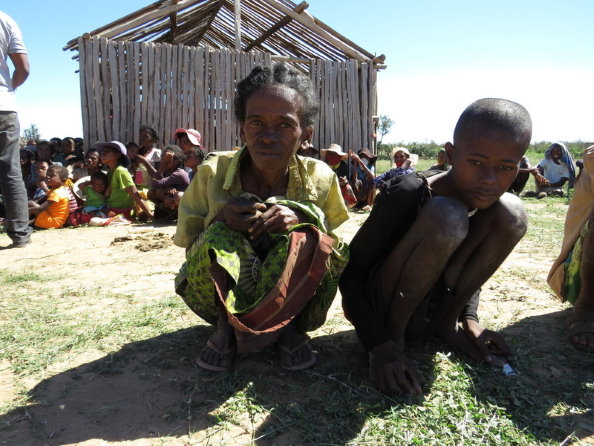
Most districts in the South are in the grip of a nutrition emergency with Global Acute Malnutrition (GAM) in children under five almost doubling over the last four months, touching an alarming 16.5 percent, as per a recent assessment conducted by the Ministry of Health. Worst affected is the district of Ambovombe where GAM has crossed 27 percent, putting the lives of many children at risk. Children with acute malnutrition are four times more likely to die than healthy children.
"The scale of the catastrophe is beyond belief. If we don't reverse this crisis, if we don't get food to the people in the south of Madagascar, families will starve and lives will be lost," said WFP's Senior Director of Operations, Amer Daoudi who today visited one of the worst affected areas, Sihanamaro, accompanied by a high-level delegation of ambassadors and senior government officials.
"We have witnessed heart-breaking scenes of severely malnourished children and starving families. We need the money and resources now to help the people of Madagascar.
WFP needs US$74 million for the next six months to save the lives in southern Madagascar and prevent a catastrophe. Following alarm calls received from Amboasary district on the severity of the food crisis, WFP has been progressively assisting up to 750,000 people through food and cash distributions each month.
Consecutive years of drought in the South have left at least 1.35 million people in need of emergency food and nutrition assistance. The situation has been critical since September 2020, the start of the lean season when families had already depleted their food supplies and eaten their vital seed stocks, leaving nothing for the November/December 2020 planting season. Currently, up to 80% of the population in certain areas in the south is resorting to desperate survival measures such as eating locusts, raw red cactus fruits or wild leaves.
The 2021 harvest prospects are poor, with the failure of the rains during the last planting season indicating another failed harvest and as a result a longer tougher lean season (from October 2021 to March 2022). Food production in 2021 is expected to be less than 40 percent of the last five-year average, making it harder for communities on the brink of survival to feed themselves.
Semi-arid conditions in southern Madagascar, combined with high levels of soil erosion, deforestation and unprecedented drastic sandstorms, have covered croplands and pasture with sand and transformed arable land into wasteland across the region.
Please find images of the situation in southern Madagascar here






